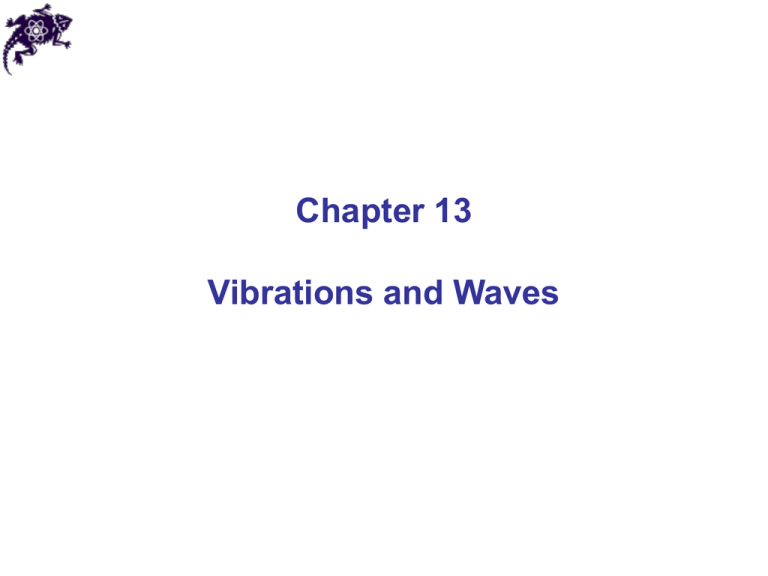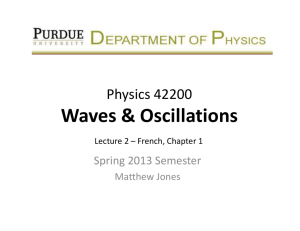Chapter 13
advertisement

Chapter 13 Vibrations and Waves Periodic motion • Periodic (harmonic) motion – self-repeating motion • Oscillation – periodic motion in certain direction • Period (T) – a time duration of one oscillation • Frequency (f) – the number of oscillations per unit time, SI unit of frequency 1/s = Hz (Hertz) 1 f T Heinrich Hertz (1857-1894) Motion of the spring-mass system • Hooke’s law: F kx • The force always acts toward the equilibrium position: restoring force • The mass is initially pulled to a distance A and released from rest • As the object moves toward the equilibrium position, F and a decrease, but v increases Motion of the spring-mass system • At x = 0, F and a are zero, but v is a maximum • The object’s momentum causes it to overshoot the equilibrium position • The force and acceleration start to increase in the opposite direction and velocity decreases • The motion momentarily comes to a stop at x = - A Motion of the spring-mass system • It then accelerates back toward the equilibrium position • The motion continues indefinitely • The motion of a spring mass system is an example of simple harmonic motion Simple harmonic motion • Simple harmonic motion – motion that repeats itself and the displacement is a sinusoidal function of time x(t ) A cos(t ) Amplitude • Amplitude – the magnitude of the maximum displacement (in either direction) x(t ) A cos(t ) Phase x(t ) A cos(t ) Phase constant x(t ) A cos(t ) Angular frequency x(t ) A cos(t ) 0 A cos t A cos (t T ) cos cos( 2 ) cos(t 2 ) cos (t T ) 2 T 2 T 2f Period x(t ) A cos(t ) T 2 Velocity of simple harmonic motion x(t ) A cos(t ) v(t ) A sin( t ) Acceleration of simple harmonic motion x(t ) A cos(t ) a(t ) A cos(t ) 2 a(t ) x(t ) 2 The force law for simple harmonic motion • From the Newton’s Second Law: 2 F ma m x • For simple harmonic motion, the force is proportional to the displacement • Hooke’s law: F kx k m 2 k m m T 2 k Energy in simple harmonic motion • Potential energy of a spring: U (t ) kx / 2 (kA / 2) cos (t ) 2 2 2 • Kinetic energy of a mass: K (t ) mv / 2 (m A / 2) sin (t ) 2 2 (kA / 2) sin (t ) 2 2 2 2 m k 2 Energy in simple harmonic motion U (t ) K (t ) (kA / 2) cos (t ) (kA / 2) sin (t ) 2 2 2 2 (kA / 2) cos (t ) sin (t ) 2 (kA / 2) 2 2 2 E U K (kA / 2) 2 Energy in simple harmonic motion kA / 2 kx / 2 mv / 2 2 2 2 k 2 2 v A x m A x mv / k 2 A 2 2 x 2 2 E U K (kA / 2) 2 Chapter 13 Problem 11 A simple harmonic oscillator has a total energy E. (a) Determine the kinetic and potential energies when the displacement is one-half the amplitude. (b) For what value of the displacement does the kinetic energy equal the potential energy? Pendulums • Simple pendulum: • Restoring torque: L( Fg sin ) • From the Newton’s Second Law: I L( Fg sin ) • For small angles sin mgL I Pendulums • Simple pendulum: at L s L mgL I mgL a s I • On the other hand a(t ) x(t ) 2 mgL I Pendulums • Simple pendulum: mgL I mgL 2 mL 2 I mL 2 g L L T 2 g Pendulums • Physical pendulum: mgh I 2 I T 2 mgh Chapter 13 Problem 32 An aluminum clock pendulum having a period of 1.00 s keeps perfect time at 20.0°C. (a) When placed in a room at a temperature of –5.0°C, will it gain time or lose time? (b) How much time will it gain or lose every hour? Simple harmonic motion and uniform circular motion • Simple harmonic motion is the projection of uniform circular motion on the diameter of the circle in which the circular motion occurs Simple harmonic motion and uniform circular motion • Simple harmonic motion is the projection of uniform circular motion on the diameter of the circle in which the circular motion occurs x(t ) A cos(t ) vx (t ) A sin( t ) Simple harmonic motion and uniform circular motion • Simple harmonic motion is the projection of uniform circular motion on the diameter of the circle in which the circular motion occurs x(t ) A cos(t ) vx (t ) A sin( t ) Simple harmonic motion and uniform circular motion • Simple harmonic motion is the projection of uniform circular motion on the diameter of the circle in which the circular motion occurs x(t ) A cos(t ) a x (t ) A cos(t ) 2 Damped simple harmonic motion Fb bv Damping force Damping constant Forced oscillations and resonance • Swinging without outside help – free oscillations • Swinging with outside help – forced oscillations • If ωd is a frequency of a driving force, then forced oscillations can be described by: x(t ) A(d / , b) cos(d t ) • Resonance: d Forced oscillations and resonance • Tacoma Narrows Bridge disaster (1940) Wave motion • A wave is the motion of a disturbance • All waves carry energy and momentum Types of waves • Mechanical – governed by Newton’s laws and exist in a material medium (water, air, rock, ect.) • Electromagnetic – governed by electricity and magnetism equations, may exist without any medium • Matter – governed by quantum mechanical equations Types of waves Depending on the direction of the displacement relative to the direction of propagation, we can define wave motion as: • Transverse – if the direction of displacement is perpendicular to the direction of propagation • Longitudinal – if the direction of displacement is parallel to the direction of propagation Types of waves Depending on the direction of the displacement relative to the direction of propagation, we can define wave motion as: • Transverse – if the direction of displacement is perpendicular to the direction of propagation • Longitudinal – if the direction of displacement is parallel to the direction of propagation Superposition of waves • Superposition principle – overlapping waves algebraically add to produce a resultant (net) wave • Overlapping solutions of the linear wave equation do not in any way alter the travel of each other Sinusoidal waves • One of the most characteristic solutions of the linear wave equation is a sinusoidal wave: y ( x vt) A sin( k ( x vt) ) A cos( k ( x vt) / 2) • A – amplitude, φ – phase constant Wavelength y ( x, t ) A cos( k ( x vt) ) • “Freezing” the solution at t = 0 we obtain a sinusoidal function of x: y ( x,0) A cos( kx ) • Wavelength λ – smallest distance (parallel to the direction of wave’s travel) between repetitions of the wave shape Wave number y ( x,0) A cos( kx ) A cos( k ( x ) ) A cos( kx k ) • On the other hand: cos( kx ) cos( kx 2 ) • Angular wave number: k = 2π / λ k 2 / Angular frequency y ( x, t ) A cos( k ( x vt) ) • Considering motion of the point at x = 0 we observe a simple harmonic motion (oscillation) : y (0, t ) A cos( kvt ) A cos( kvt ) • For simple harmonic motion: y (t ) A cos(t ) kv 2v / • Angular frequency ω Frequency, period • Definitions of frequency and period are the same as for the case of rotational motion or simple harmonic motion: f 1 / T / 2 T 2 / • Therefore, for the wave velocity v / k / T f y ( x, t ) A cos( kx t ) Wave velocity • v is a constant and is determined by the properties of the medium • E.g., for a stretched string with linear density μ m/l under tension T v T = Chapter 13 Problem 41 A harmonic wave is traveling along a rope. It is observed that the oscillator that generates the wave completes 40.0 vibrations in 30.0 s. Also, a given maximum travels 425 cm along the rope in 10.0 s. What is the wavelength? Interference of waves • Interference – a phenomenon of combining waves, which follows from the superposition principle • Considering two sinusoidal waves of the same amplitude, wavelength, and direction of propagation y1 ( x, t ) A cos(kx t ) • The resultant wave: y2 ( x, t ) A cos(kx t ) y( x, t ) y1 ( x, t ) y2 ( x, t ) A cos( kx t ) A cos( kx t ) 2 A cos( / 2) cos( kx t / 2) cos cos 2 cos 2 cos 2 Interference of waves y ( x, t ) 2 A cos( / 2) cos( kx t / 2) • If φ = 0 (Fully constructive) y ( x, t ) 2 A cos( kx t ) • If φ = π (Fully destructive) y ( x, t ) 0 • If φ = 2π/3 (Intermediate) y ( x, t ) 2 A cos( / 3) cos( kx t / 3) A cos( kx t / 3) Reflection of waves at boundaries • Within media with boundaries, solutions to the wave equation should satisfy boundary conditions. As a results, waves may be reflected from boundaries • Hard reflection – a fixed zero value of deformation at the boundary – a reflected wave is inverted • Soft reflection – a free value of deformation at the boundary – a reflected wave is not inverted Questions? Answers to the even-numbered problems Chapter 13 Problem 2 (a) 1.1 × 102 N (b) The graph is a straight line passing through the origin with slope equal to k = 1.0 × 103 N/m. Answers to the even-numbered problems Chapter 13 Problem 8 (a) 575 N/m (b) 46.0 J Answers to the even-numbered problems Chapter 13 Problem 12 (a) 2.61 m/s (b) 2.38 m/s Answers to the even-numbered problems Chapter 13 Problem 16 (a) 0.15 J (b) 0.78 m/s (c) 18 m/s2







